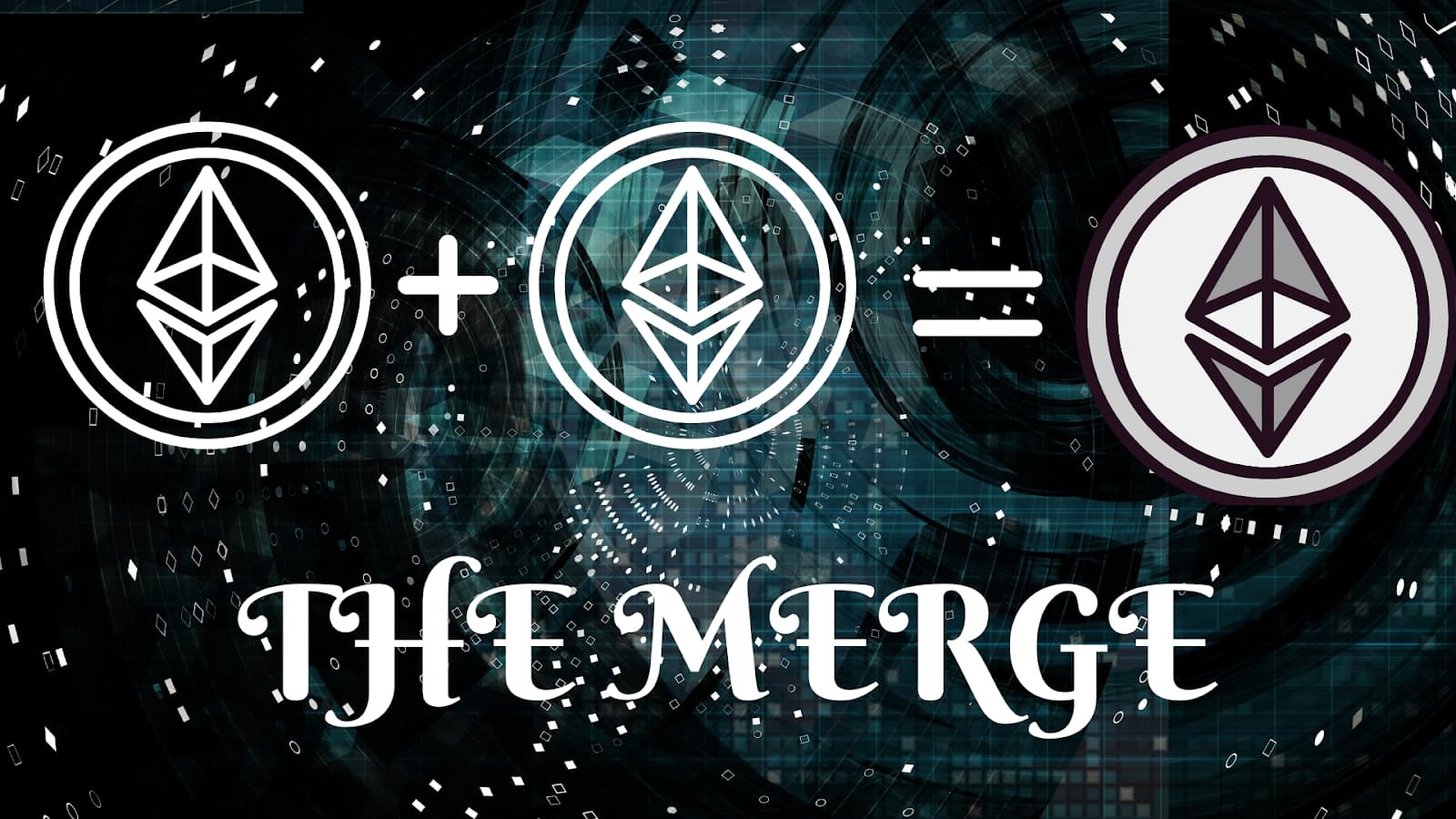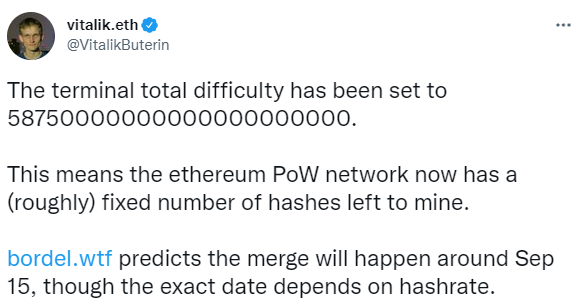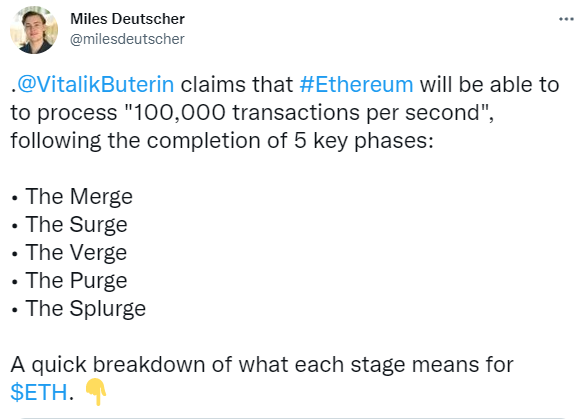The Ethereum (ETH) Merge : What to Expect

There’s so much buzz surrounding the hugely anticipated Ethereum upgrade — The Merge — labeled the most significant event in the crypto space in 2022.
Ethereum is the most traded cryptocurrency for NFT transactions. It is only behind Bitcoin in value and transaction volume.
Following the bearish market beginning on June 13, there’s been a massive crash in ETH value from an all-time high of $4,800 to a measly $880 on June 20. Everyone hopes the upcoming upgrade will put an end to the disastrous dip.
Is the Merge the savior in the ongoing crash? Or perhaps, it will reduce the outrageous gas fees. Again, Why is it even happening? Let’s find out!
What Exactly is the Merge?
As we know, the Ethereum Mainnet runs on a Proof-of-Work (PoW) consensus mechanism — an energy-consuming algorithm where miners solve cryptographical and complex computation problems to confirm blocks.
Now, Ethereum wants to add more stability to its blockchain. And the developers figured the best way to do it is by shifting its execution layer from a PoW to a PoS (Proof-of-Stake) consensus.
The PoS consensus is known as the Beacon Chain. The layer brings more security and consumes less energy. It involves validators — people with 32 ETH — staking their coins to verify blocks. Validators receive cryptocurrency as a reward for accurate verification. It’s also worth noting that people who can’t afford 32 ETH can also take part in the confirmation by staking in mining pools.
Here’s how the Merge works — the Ethereum Mainnet runs parallel with the Beacon Chain. The Merge involves joining the existing execution layer to the Beacon Chain — providing the blockchain network with more security, sustainability, and scalability.
When Is the Merge Happening?
Yes, finally, the moment of truth is upon us!
Ethereum developers have announced that the Merge might happen pretty soon — following the successful transition of each testnet Merge — the Ropsten test, Sepolia test, and Goerli test have all been merged with the Mainnet.
To make things super clear, Ethereum’s co-founder “Vitalik” recently provided an update regarding the exact date for the Merge to happen. Of course, it is also liable to change.


What Are the Testnet Merges?
Although we don’t know when the official Ethereum Merge will occur, there has been a few merges with the Beacon Chain. Sounds confusing? Here’s what it means — before the transition to the PoS consensus, there has been a successful run of minor upgrades to the Ethereum Mainnet.
Below are the concluded Testnet Merges:
Ropsten Testnet
This was the first testnet merge to successfully upgrade from the PoW mechanism to the Beacon Chain consensus. It concluded on June 8, 2022.
Sepolia Testnet
Shortly after completing the Ropsten testnet merge, Sepolia was also updated. It was a two-step process and was concluded on July 6, 2022.
Goerli Testnet
The most recent merge to the Ethereum Mainnet is the Goerli Testnet — completed on the 10th of August, 2022.
This is the penultimate merge before the highly anticipated Mainnet Merge to the Beacon Chain consensus — presumed to happen in late September.
What Are the Expected Changes After the Merge?
Now that we know the Merge is close let’s look at the changes and upgrades it will bring to the Ethereum Blockchain.
Validators Replace Miners
The new consensus layer will integrate validators into the verification process of Ethereum blocks rather than miners used in the PoW mechanism.
Block Rewards Reduced by up to 90%
Miners in the PoW execution layer get up to 13,000 ETH daily as mining rewards and 1,600 ETH for staking. With the incumbent PoS mechanism, only the staking rewards will remain — dropping the total ETH block rewards by 90%.
The Blockchain Becomes More Scalable
A stunning feature the Merge will bring to the Ethereum Mainnet is more scalability — enabling the blockchain network to perform numerous transactions per second, making transactions seamless and more cost-effective.
Increase in Blockchain Security
Another significant improvement in the Merge anchors is an increase in block security. The PoS consensus works so that the blockchain becomes more secure as more blocks are verified on the network.
More Sustainability
One of the core functions of the PoW algorithm is that it solves complex computation problems. Still, it equally consumes a high amount of energy — PoS will eradicate that and reduce the energy-consuming algorithm making Ethereum 99.9% more efficient.
Introduction of the Slashing Feature
Validators are saddled with verifying the blocks on the Ethereum network, but that’s not all — they also monitor other validators. If a validator is proven to be malicious, other validators will slash such behavior.
There is no reward to validators for slashing, but the guilty party will suffer a gradual loss of ETH. The penalties can also be severe, barring validators from participating in the network.
Fixed Block Times
Under the current PoW execution layer, miners confirm blocks at varying times. Block verification is unpredictable, so every second is valuable. Conversely, the PoS consensus allows validators to verify blocks every 12 seconds.
Misconceptions About The Merge
There’s so much fuss about what the Merge will bring to the table but sorry to burst your bubble — it won’t reduce gas fees.
Gas fees are probably the most notable change everyone looks forward to, but other expected changes won’t happen. At least, not after the Merge.
Here are things you might have gotten all wrong:
Reduction in Gas Fees
The song on everyone’s lips is “The Merge will reduce gas fees.” Well, not at all.
The new consensus layer will make Ethereum more scalable, but it won’t expand the blockchain’s network capacity — gas fees won’t reduce.
Running a Node Requires 32 ETH
You don’t have to stake 32 ETH to run a node on the Ethereum network — neither the PoW nor the PoS consensus supports this.
There are two types of nodes; those that propose blocks and those that don’t. Only miners and validators on respective layers are allowed to propose blocks. The majority of users don’t have to, and it doesn’t affect their vitality to the blockchain.
Withdrawal of Staked ETH
Again, you know the drill — you can’t withdraw your staked ETH nor your rewards, pre-merge or post-merge. But hey! It’s not all that bad, as withdrawals will be activated in the Shangai upgrade — which comes after the Merge.
Increase in Transaction Speed
Another fantasy that won’t come true is increased transaction speed. No!! Transactions won’t be faster after the merge; they will remain the same. Although bar any slight surprises, there will be slight changes in the verification process.
There Will Be a Network Downtime During Merge
As excitement raves on, perhaps, some people still panic — the reason being a possible network downtime during the transition of Ethereum Mainnet to the Beacon Chain layer.
Fret not; no such thing will happen. The Merge will be a smooth transition with zero downtime.
Triple Value of Staked APR
It’s presumed that staked APR will triple post-merge, but I hate to break it to you that it is far from the truth — your APR will be no more than 50%.
What’s Coming to Ethereum (ETH) After the Merge?
Not too long ago, Vitalik stated that Ethereum would soon be able to process 100,000 transactions per second. Well, yes, but not so soon.
The Merge is the first of a 5-stage process of blockchain development. Let’s take a quick look at the upgrades to come after the Merge.


The Surge
The Surge is the next upgrade after the Merge. The layer will introduce sharding to the Mainnet — a scaling solution designed to spread the computational load around the network.
The Verge
After the Surge, the next phase is the Verge. It is a solution that will optimize the data storage for validators through the use of Merkle proofs.
The Purge
The penultimate upgrade is the Purge. On a similar note to the Verge, it will reduce network congestion and optimize data storage for validators.
The Splurge
And finally, the last upgrade in the protocol’s development — the Splurge. It encompasses all fixes to previous upgrades and ensures overall network performance.
Conclusion
Everyone got a little bit carried away by the impression that The Merge will improve the Ethereum blockchain network and reduce gas fees and all that. Well, not everything presumed will happen for sure, and we can all see that now.
Conversely, the Merge is sure to pack a lot of punch, and we can't wait to see its influence on the Ethereum network.
0 Comments Add a Comment?